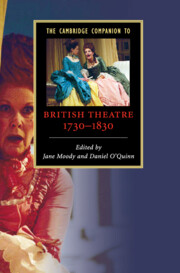Book contents
- Frontmatter
- Part I Performance
- Part II Genres
- Part III Identities
- 9 The making of an English audience: the case of the footmen’s gallery
- 10 Women playwrights
- 11 Entertaining women: the actress in eighteenth-century theatre and culture
- 12 Race and profit in English theatre
- Part IV Places of Performance
- Part V Further Reading
- Bibliography
- Index
- Series list
9 - The making of an English audience: the case of the footmen’s gallery
from Part III - Identities
Published online by Cambridge University Press: 28 May 2009
- Frontmatter
- Part I Performance
- Part II Genres
- Part III Identities
- 9 The making of an English audience: the case of the footmen’s gallery
- 10 Women playwrights
- 11 Entertaining women: the actress in eighteenth-century theatre and culture
- 12 Race and profit in English theatre
- Part IV Places of Performance
- Part V Further Reading
- Bibliography
- Index
- Series list
Summary
The story of London theatre audiences in the eighteenth century has been told by cultural historians Peter Stallybrass and Allon White as the gradual displacement of rowdy, carnivalesque participation by the decorum of highart consumption. Drawing on Norbert Elias's History of Manners and the work of sociologist Pierre Bourdieu, Stallybrass and White narrate emerging demands for the audience to assume the docile role of quiet attentiveness and 'appropriate' reaction to the performance on the stage: 'what is new . . . is the urgent attempt to expel the lower sort altogether from the scene of reception, to homogenise the audience by refining and domesticating its energy, sublimating its diverse physical pleasures into a purely contemplative force, replacing a dispersed, heterodox, noisy participation in the event of theatre by silent specular intensity'. Stallybrass and White frame this story about audiences in the grand narrative of the middle class' ubiquitous 'rise' and the emergence of a 'bourgeois public sphere'. Unfortunately, their narrative, however elegant, has limited studies of eighteenth-century spectatorship by obscuring the specific processes by which particular audience members, struggled for and ultimately lost the right to public voices and behaviours not consonant with the 'bourgeois public sphere'.
We need more information about the social identities and relations of eighteenth-century British audiences; more is at stake in this knowledge than a history of dramatic reception. As Lisa A. Freeman concludes, 'the semiotics of placement within the theater provided for an intense experience of the socioeconomic conditions that regulated society at large and made patently clear the kinds of competing interests that had to be negotiated within that culture. Social rank was as significant an element in the experience of the theatrical space as it was in the meaning of the plays performed.'
- Type
- Chapter
- Information
- The Cambridge Companion to British Theatre, 1730–1830 , pp. 131 - 144Publisher: Cambridge University PressPrint publication year: 2007



